List Of Birds Of Black Canyon Of The Gunnison National Park
This list is presented in the taxonomic sequence of the Check-list of North and Middle American Birds, 7th edition through the 65th Supplement, published by the American Ornithological Society (AOS). Common and scientific names are also those of the Check-list, except that the common names of families are from the Clements taxonomy because the AOS list does not include them.
The following codes and definitions are used to annotate some species. The others are residents, seasonal visitors, or migrants which one can expect to see in the proper season and habitat.
- (PP) = Probably present - "High confidence species occurs in park but current, verified evidence needed" per the NPS (31 species)
- (R) = Rare - "Present, but usually seen only a few times each year" per the NPS (38 species)
- (O) = Occasional - "Occurs in the park at least once every few years, varying in numbers, but not necessarily every year" per the NPS (11 species)
- (Unk) = Unknown - "Abundance unknown" per the NPS (two species)
- (I) = Introduced - a species introduced to North America by humans (five species)
Ducks, geese, and waterfowl




Order: Anseriformes Family: Anatidae
The family Anatidae includes the ducks and most duck-like waterfowl, such as geese and swans. These birds are adapted to an aquatic existence with webbed feet, bills which are flattened to a greater or lesser extent, and feathers that are excellent at shedding water due to special oils.
- Canada goose, Branta canadensis
- Blue-winged teal, Spatula discors (PP)
- Cinnamon teal, Spatula cyanoptera (PP)
- Northern shoveler, Spatula clypeata (PP)
- Gadwall, Mareca strepera (PP)
- American wigeon, Mareca americana
- Mallard, Anas platyrhynchos
- Northern pintail, Anas acuta (PP)
- Green-winged teal, Anas crecca (PP)
- Redhead, Aythya americana (PP)
- Lesser scaup, Aythya affinis (PP)
- Common goldeneye, Bucephala clangula
- Barrow's goldeneye, Bucephala islandica (O)
- Hooded merganser, Lophodytes cucullatus (O)
- Common merganser, Mergus merganser
- Ruddy duck, Oxyura jamaicensis (PP)
New World quail
Order: Galliformes Family: Odontophoridae
The New World quails are small, plump terrestrial birds only distantly related to the quails of the Old World, but named for their similar appearance and habits.
- Gambel's quail, Callipepla gambelii (PP)
Pheasants, grouse, and allies
Order: Galliformes Family: Phasianidae
Phasianidae consists of the pheasants and their allies. These are terrestrial species, variable in size but generally plump with broad and relatively short wings. Many species are gamebirds or have been domesticated as a food source for humans.
- Wild turkey, Meleagris gallopavo (O)
- Gunnison sage-grouse, Centrocercus minimus (R)
- Dusky grouse, Dendragapus obscurus
- Sharp-tailed grouse, Tympanuchus phasianellus (H)
- Ring-necked pheasant, Phasianus colchicus (I) (O)
- Chukar, Alectoris chukar (I) (R)
Grebes
Order: Podicipediformes Family: Podicipedidae
Grebes are small to medium-large freshwater diving birds. They have lobed toes and are excellent swimmers and divers. However, they have their feet placed far back on the body, making them quite ungainly on land.
- Pied-billed grebe, Podilymbus podiceps (PP)
Pigeons and doves
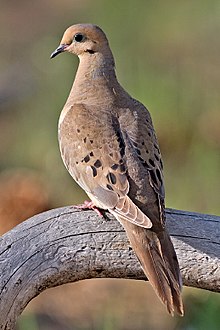
Order: Columbiformes Family: Columbidae
Pigeons and doves are stout-bodied birds with short necks and short slender bills with a fleshy cere.
- Rock pigeon, Columba livia (I)
- Band-tailed pigeon, Patagioenas fasciata (R)
- Mourning dove, Zenaida macroura
Nightjars and allies
Order: Caprimulgiformes Family: Caprimulgidae
Nightjars, also called goatsuckers, are medium-sized nocturnal birds that usually nest on the ground. They have long wings, short legs, and very short bills. Most have small feet, of little use for walking, and long pointed wings. Their soft plumage is cryptically colored to resemble bark or leaves.
- Common nighthawk, Chordeiles minor
- Common poorwill, Phalaenoptilus nuttallii
Hummingbirds

Order: Apodiformes Family: Trochilidae
Hummingbirds are small birds capable of hovering in mid-air due to the rapid flapping of their wings. They are the only birds that can fly backwards.
- Black-chinned hummingbird, Archilochus alexandri (R)
- Calliope hummingbird, Selasphorus calliope (PP)
- Rufous hummingbird, Selasphorus rufus
- Broad-tailed hummingbird, Selasphorus platycercus
Rails, gallinules, and coots
Order: Gruiformes Family: Rallidae
Rallidae is a large family of small to medium-sized birds which includes the rails, crakes, coots, and gallinules. The most typical family members occupy dense vegetation in damp environments near lakes, swamps, or rivers. In general they are shy and secretive birds, making them difficult to observe. Most species have strong legs and long toes which are well adapted to soft uneven surfaces. They tend to have short, rounded wings and tend to be weak fliers.
- American coot, Fulica americana (PP)
Cranes
Order: Gruiformes Family: Gruidae
Cranes are large, long-legged, and long-necked birds. Unlike the similar-looking but unrelated herons, cranes fly with necks outstretched, not pulled back. Most have elaborate and noisy courting displays or "dances".
- Sandhill crane, Antigone canadensis
Plovers and lapwings
Order: Charadriiformes Family: Charadriidae
The family Charadriidae includes the plovers, dotterels, and lapwings. They are small to medium-sized birds with compact bodies, short thick necks, and long, usually pointed, wings. They are found in open country worldwide, mostly in habitats near water.
- Killdeer, Charadrius vociferus
Sandpipers and allies
Order: Charadriiformes Family: Scolopacidae
Scolopacidae is a large diverse family of small to medium-sized shorebirds including the sandpipers, curlews, godwits, shanks, tattlers, woodcocks, snipes, dowitchers, and phalaropes. The majority of these species eat small invertebrates picked out of the mud or soil. Different lengths of legs and bills enable multiple species to feed in the same habitat, particularly on the coast, without direct competition for food.
- Wilson's snipe, Gallinago delicata (PP)
- Spotted sandpiper, Actitis macularia
Gulls, terns, and skimmers
Order: Charadriiformes Family: Laridae
Laridae is a family of medium to large seabirds and includes jaegers, skuas, gulls, terns, kittiwakes, and skimmers. They are typically gray or white, often with black markings on the head or wings. They have stout, longish bills and webbed feet.
- Franklin's gull, Leucophaeus pipixcan (PP)
- Ring-billed gull, Larus delawarensis (PP)
- California gull, Larus californicus (PP)
Herons, egrets, and bitterns

Order: Pelecaniformes Family: Ardeidae
The family Ardeidae contains the herons, egrets, and bitterns. Herons and egrets are medium to large wading birds with long necks and legs. Bitterns tend to be shorter necked and more secretive. Members of Ardeidae fly with their necks retracted, unlike other long-necked birds such as storks, ibises, and spoonbills.
- Great blue heron, Ardea herodias
- Black-crowned night-heron, Nycticorax nycticorax (PP)
New World vultures

Order: Cathartiformes Family: Cathartidae
The New World vultures are not closely related to Old World vultures, but superficially resemble them because of convergent evolution. Like the Old World vultures, they are scavengers, however, unlike Old World vultures, which find carcasses by sight, New World vultures have a good sense of smell with which they locate carcasses.
- Turkey vulture, Cathartes aura
Osprey
Order: Accipitriformes Family: Pandionidae
Pandionidae is a monotypic family of fish-eating birds of prey. Its single species possesses a very large and powerful hooked beak, strong legs, strong talons, and keen eyesight.
- Osprey, Pandion haliaetus (R)
Hawks, eagles, and kites

Order: Accipitriformes Family: Accipitridae
Accipitridae is a family of birds of prey which includes hawks, eagles, kites, harriers, and Old World vultures. These birds have very large powerful hooked beaks for tearing flesh from their prey, strong legs, powerful talons, and keen eyesight.
- Golden eagle, Aquila chrysaetos
- Northern harrier, Circus hudsonius
- Sharp-shinned hawk, Accipiter striatus
- Cooper's hawk, Accipiter cooperii
- American goshawk, Accipiter atricapillus (R)
- Bald eagle, Haliaeetus leucocephalus
- Swainson's hawk, Buteo swainsoni (R)
- Red-tailed hawk, Buteo jamaicensis
- Rough-legged hawk, Buteo lagopus (PP)
- Ferruginous hawk, Buteo regalis (PP)
Barn-owls
Order: Strigiformes Family: Tytonidae
Barn-owls are medium to large owls with large heads and characteristic heart-shaped faces. They have long strong legs with powerful talons.
- Barn owl, Tyto alba (O)
Owls
Order: Strigiformes Family: Strigidae
Typical owls are small to large solitary nocturnal birds of prey. They have large forward-facing eyes and ears, a hawk-like beak, and a conspicuous circle of feathers around each eye called a facial disk.
- Flammulated owl, Psiloscops flammeolus (O)
- Great horned owl, Bubo virginianus
- Northern pygmy-owl, Glaucidium gnoma (R)
- Long-eared owl, Asio otus (R)
- Northern saw-whet owl, Aegolius acadicus (R)
Kingfishers
Order: Coraciiformes Family: Alcedinidae
Kingfishers are medium-sized birds with large heads, long pointed bills, short legs, and stubby tails.
- Belted kingfisher, Megaceryle alcyon (R)
Woodpeckers
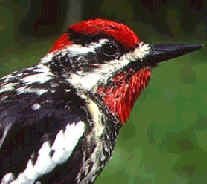
Order: Piciformes Family: Picidae
Woodpeckers are small to medium-sized birds with chisel-like beaks, short legs, stiff tails, and long tongues used for capturing insects. Some species have feet with two toes pointing forward and two backward, while several species have only three toes. Many woodpeckers have the habit of tapping noisily on tree trunks with their beaks.
- Lewis's woodpecker, Melanerpes lewis (R)
- Williamson's sapsucker, Sphyrapicus thyroideus (R)
- Red-naped sapsucker, Sphyrapicus nuchalis (R)
- American three-toed woodpecker, Picoides dorsalis
- Downy woodpecker, Dryobates pubescens (R)
- Hairy woodpecker, Dryobates villosus (R)
- Northern flicker, Colaptes auratus
Falcons and caracaras

Order: Falconiformes Family: Falconidae
Falconidae is a family of diurnal birds of prey, notably the falcons and caracaras. They differ from hawks, eagles, and kites in that they kill with their beaks instead of their talons.
- American kestrel, Falco sparverius
- Merlin, Falco columbarius (O)
- Peregrine falcon, Falco peregrinus
- Prairie falcon, Falco mexicanus
Tyrant flycatchers
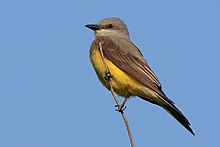
Order: Passeriformes Family: Tyrannidae
Tyrant flycatchers are Passerine birds which occur throughout North and South America. They superficially resemble the Old World flycatchers, but are more robust and have stronger bills. They do not have the sophisticated vocal capabilities of the songbirds. Most, but not all, are rather plain. As the name implies, most are insectivorous.
- Ash-throated flycatcher, Myiarchus cinerascens
- Western kingbird, Tyrannus verticalis (R)
- Olive-sided flycatcher, Contopus cooperi (R)
- Western wood-pewee, Contopus sordidulus
- Willow flycatcher, Empidonax traillii (PP)
- Hammond's flycatcher, Empidonax hammondii (R)
- Gray flycatcher, Empidonax wrightii
- Dusky flycatcher, Empidonax oberholseri
- Western flycatcher, Empidonax difficilis
- Say's phoebe, Sayornis saya
Vireos, shrike-babblers, and erpornis
Order: Passeriformes Family: Vireonidae
The vireos are a group of small to medium-sized passerine birds restricted to the New World, though a few other members of the family are found in Asia. They are typically greenish in color and resemble wood warblers apart from their heavier bills.
- Gray vireo, Vireo vicinior (R)
- Plumbeous vireo, Vireo plumbeus
- Warbling vireo, Vireo gilvus
Shrikes
Order: Passeriformes Family: Laniidae
Shrikes are passerine birds known for their habit of catching other birds and small animals and impaling the uneaten portions of their bodies on thorns. A shrike's beak is hooked, like that of a typical bird of prey.
- Loggerhead shrike, Lanius ludovicianus (R)
- Northern shrike, Lanius borealis (PP)
Crows, jays, and magpies

Order: Passeriformes Family: Corvidae
The family Corvidae includes crows, ravens, jays, choughs, magpies, treepies, nutcrackers, and ground jays. Corvids are above average in size among the Passeriformes, and some of the larger species show high levels of intelligence.
- Canada jay, Perisoreus canadensis (PP)
- Pinyon jay, Gymnorhinus cyanocephalus
- Steller's jay, Cyanocitta stelleri
- Woodhouse's scrub-jay, Aphelocoma woodhouseii
- Clark's nutcracker, Nucifraga columbiana
- Black-billed magpie, Pica hudsonia
- American crow, Corvus brachyrhynchos (R)
- Common raven, Corvus corax
Tits, chickadees, and titmice

Order: Passeriformes Family: Paridae
The Paridae are mainly small stocky woodland species with short stout bills. Some have crests. They are adaptable birds, with a mixed diet including seeds and insects.
- Black-capped chickadee, Poecile atricapilla
- Mountain chickadee, Poecile gambeli
- Juniper titmouse, Baeolophus ridgwayi
Larks
Order: Passeriformes Family: Alaudidae
Larks are small terrestrial birds with often extravagant songs and display flights. Most larks are fairly dull in appearance. Their food is insects and seeds.
- Horned lark, Eremophila alpestris (R)
Swallows

Order: Passeriformes Family: Hirundinidae
The family Hirundinidae is adapted to aerial feeding. They have a slender streamlined body, long pointed wings and a short bill with a wide gape. The feet are adapted to perching rather than walking, and the front toes are partially joined at the base.
- Tree swallow, Tachycineta bicolor
- Violet-green swallow, Tachycineta thalassina
- Barn swallow, Hirundo rustica
- Cliff swallow, Petrochelidon pyrrhonota
Long-tailed tits
Order: Passeriformes Family: Aegithalidae
Long-tailed tits are a group of small passerine birds with medium to long tails. They make woven bag nests in trees. Most eat a mixed diet which includes insects.
- Bushtit, Psaltriparus minimus
Kinglets

Order: Passeriformes Family: Regulidae
The kinglets are a small family of birds which resemble the titmice. They are very small insectivorous birds in the genus Regulus. The adults have colored crowns, giving rise to their names.
- Ruby-crowned kinglet, Corthylio calendula
- Golden-crowned kinglet, Regulus satrapa (PP)
Waxwings
Order: Passeriformes Family: Bombycillidae
The waxwings are a group of passerine birds with soft silky plumage and unique red tips to some of the wing feathers. In the Bohemian and cedar waxwings, these tips look like sealing wax and give the group its name. These are arboreal birds of northern forests. They live on insects in summer and berries in winter.
- Bohemian waxwing, Bombycilla garrulus (PP)
- Cedar waxwing, Bombycilla cedrorum (PP)
Nuthatches
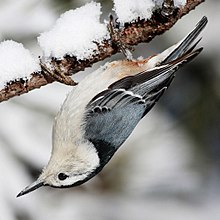
Order: Passeriformes Family: Sittidae
Nuthatches are small woodland birds. They have the unusual ability to climb down trees head first, unlike other birds which can only go upwards. Nuthatches have big heads, short tails, and powerful bills and feet.
- Red-breasted nuthatch, Sitta canadensis (R)
- White-breasted nuthatch, Sitta carolinensis
- Pygmy nuthatch, Sitta pygmaea (O)
Treecreepers
Order: Passeriformes Family: Certhiidae
Treecreepers are small woodland birds, brown above and white below. They have thin pointed down-curved bills, which they use to extricate insects from bark. They have stiff tail feathers, like woodpeckers, which they use to support themselves on vertical trees.
- Brown creeper, Certhia americana (R)
Gnatcatchers
Order: Passeriformes Family: Polioptilidae
These dainty birds resemble Old World warblers in their structure and habits, moving restlessly through the foliage seeking insects. The gnatcatchers are mainly soft bluish gray in color and have the typical insectivore's long sharp bill. Many species have distinctive black head patterns (especially males) and long, regularly cocked, black-and-white tails.
- Blue-gray gnatcatcher, Polioptila caerulea
Wrens
Order: Passeriformes Family: Troglodytidae
Wrens are small and inconspicuous birds, except for their loud songs. They have short wings and thin down-turned bills. Several species often hold their tails upright. All are insectivorous.
- Rock wren, Salpinctes obsoletus
- Canyon wren, Catherpes mexicanus
- Bewick's wren, Thryomanes bewickii
- Northern house wren, Troglodytes aedon
Mockingbirds and thrashers

Order: Passeriformes Family: Mimidae
The mimids are a family of passerine birds which includes thrashers, mockingbirds, tremblers, and the New World catbirds. These birds are notable for their vocalization, especially their remarkable ability to mimic a wide variety of birds and other sounds heard outdoors. The species tend towards dull grays and browns in their appearance.
- Gray catbird, Dumetella carolinensis (O)
- Brown thrasher, Toxostoma rufum (O)
- Sage thrasher, Oreoscoptes montanus (R)
- Northern mockingbird, Mimus polyglottos (Unk)
Starlings
Order: Passeriformes Family: Sturnidae
Starlings are small to medium-sized passerine birds with strong feet. Their flight is strong and direct and they are very gregarious. Their preferred habitat is fairly open country, and they eat insects and fruit. Plumage is typically dark with a metallic sheen.
- European starling, Sturnus vulgaris (I)
Dippers
Order: Passeriformes Family: Cinclidae
Dippers are a group of perching birds whose habitat includes aquatic environments in the Americas, Europe, and Asia. They are named for their bobbing or dipping movements. These birds have adaptations which allows them to submerge and walk on the bottom to feed on insect larvae.
- American dipper, Cinclus mexicanus
Thrushes and allies

Order: Passeriformes Family: Turdidae
The thrushes are a group of passerine birds that occur mainly but not exclusively in the Old World. They are plump, soft plumaged, small to medium-sized insectivores or sometimes omnivores, often feeding on the ground. Many have attractive songs.
- Western bluebird, Sialia mexicana
- Mountain bluebird, Sialia currucoides
- Townsend's solitaire, Myadestes townsendi
- Swainson's thrush, Catharus ustulatus
- Hermit thrush, Catharus guttatus
- American robin, Turdus migratorius
Old World sparrows
Order: Passeriformes Family: Passeridae
Old World sparrows are small passerine birds. In general, sparrows tend to be small plump brownish or grayish birds with short tails and short powerful beaks. Sparrows are seed eaters, but they also consume small insects.
- House sparrow, Passer domesticus (I) (R)
Wagtails and pipits
Order: Passeriformes Family: Motacillidae
Motacillidae is a family of small passerine birds with medium to long tails. They include the wagtails, longclaws, and pipits. They are slender ground-feeding insectivores of open country.
- American pipit, Anthus rubescens (PP)
Finches, euphonias, and allies

Order: Passeriformes Family: Fringillidae
Finches are seed-eating passerine birds that are small to moderately large and have a strong beak, usually conical and in some species very large. All have twelve tail feathers and nine primaries. These birds have a bouncing flight with alternating bouts of flapping and gliding on closed wings, and most sing well.
- Evening grosbeak, Coccothraustes vespertinus (R)
- Pine grosbeak, Pinicola enucleator (PP)
- Gray-crowned rosy-finch, Leucosticte tephrocotis (R)
- Black rosy-finch, Leucosticte atrata (R)
- Brown-capped rosy-finch, Leucosticte australis (PP)
- House finch, Haemorhous mexicanus (R)
- Cassin's finch, Haemorhous cassinii (R)
- Red crossbill, Loxia curvirostra (R)
- Pine siskin, Spinus pinus
- Lesser goldfinch, Spinus psaltria
- American goldfinch, Spinus tristis
New World sparrows

Order: Passeriformes Family: Passerellidae
Until 2017, these species were considered part of the family Emberizidae. Most of the species are known as sparrows, but these birds are not closely related to the Old World sparrows which are in the family Passeridae. Many of these have distinctive head patterns.
- Black-throated sparrow, Amphispiza bilineata (R)
- Lark sparrow, Chondestes grammacus (R)
- Chipping sparrow, Spizella passerina
- Brewer's sparrow, Spizella breweri
- American tree sparrow, Spizelloides arborea (PP)
- Dark-eyed junco, Junco hyemalis
- White-crowned sparrow, Zonotrichia leucophrys
- Vesper sparrow, Pooecetes gramineus
- Song sparrow, Melospiza melodia
- Lincoln's sparrow, Melospiza lincolnii (PP)
- Green-tailed towhee, Pipilo chlorurus
- Spotted towhee, Pipilo maculatus
Yellow-breasted chat
Order: Passeriformes Family: Icteriidae
This species was historically placed in the wood-warblers (Parulidae) but nonetheless most authorities were unsure if it belonged there. It was placed in its own family in 2017.
- Yellow-breasted chat, Icteria virens (R)
Troupials and allies
Order: Passeriformes Family: Icteridae
The icterids are a group of small to medium-sized, often colorful passerine birds restricted to the New World and include the grackles, New World blackbirds, and New World orioles. Most species have black as a predominant plumage color, often enlivened by yellow, orange, or red.
- Western meadowlark, Sturnella neglecta
- Bullock's oriole, Icterus bullockii (R)
- Red-winged blackbird, Agelaius phoeniceus
- Brown-headed cowbird, Molothrus ater
- Brewer's blackbird, Euphagus cyanocephalus
New World warblers

Order: Passeriformes Family: Parulidae
The wood warblers are a group of small often colorful passerine birds restricted to the New World. Most are arboreal, but some, like the ovenbird and the two waterthrushes, are more terrestrial. Most members of this family are insectivores.
- Orange-crowned warbler, Leiothlypis celata
- Virginia's warbler, Leiothlypis virginiae
- MacGillivray's warbler, Geothlypis tolmiei
- Yellow warbler, Setophaga petechia
- Yellow-rumped warbler, Setophaga coronata
- Black-throated gray warbler, Setophaga nigrescens
- Townsend's warbler, Setophaga townsendi (R)
- Wilson's warbler, Cardellina pusilla
Cardinals and allies
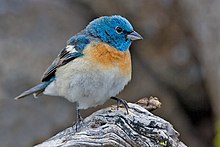
Order: Passeriformes Family: Cardinalidae
The cardinals are a family of robust, seed-eating birds with strong bills. They are typically associated with open woodland. The sexes usually have distinct plumages.
- Western tanager, Piranga ludoviciana
- Black-headed grosbeak, Pheucticus melanocephalus
- Blue grosbeak, Passerina caerulea (Unk)
- Lazuli bunting, Passerina amoena
- Indigo bunting, Passerina cyanea (O)
References
- ^ "Bird Species Checklist". National Park Service. Retrieved July 19, 2024.
- ^ "Check-list of North and Middle American Birds". American Ornithological Society. July 2024. Retrieved July 18, 2024.
See also
- List of birds
- Lists of birds by region
- List of North American birds
- List of birds of Colorado
- List of birds of Rocky Mountain National Park
- Bibliography of Colorado
- Geography of Colorado
- History of Colorado
- Index of Colorado-related articles
- List of Colorado-related lists
- Outline of Colorado